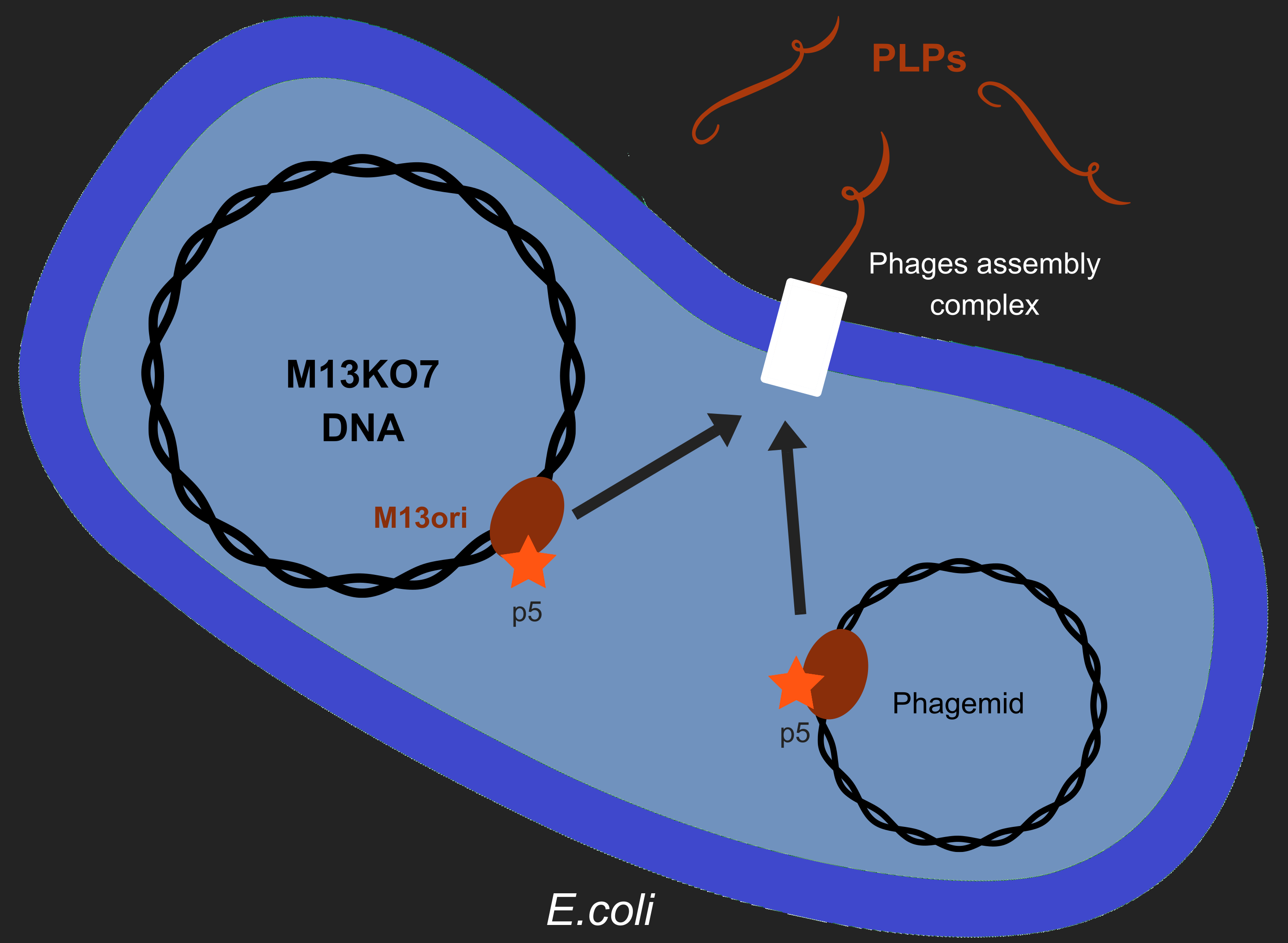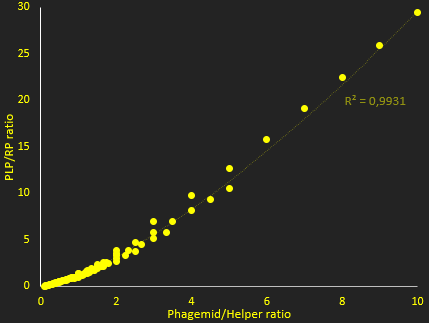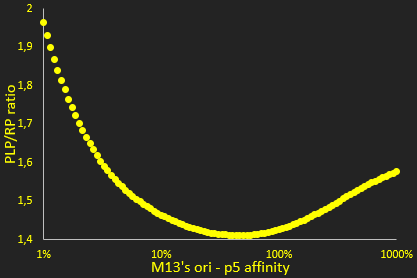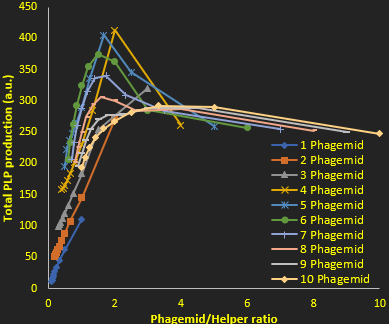Erwan Eriau (Talk | contribs) (table) |
|||
| Line 26: | Line 26: | ||
This was done by adapting the existing model and adding new parts to the existing model. | This was done by adapting the existing model and adding new parts to the existing model. | ||
These modifications added 9 species and 3 parameters and 13 equations to the original model, and changed 8 parts of the previous model. | These modifications added 9 species and 3 parameters and 13 equations to the original model, and changed 8 parts of the previous model. | ||
| + | The new equations are the following: | ||
| + | |||
| + | We made the following assumptions to devise our model: | ||
| + | <TABLE BORDER="1"> | ||
| + | <CAPTION> Table 1: Assumptions </CAPTION> | ||
| + | <TR> | ||
| + | <TH> Assumption </TH> | ||
| + | <TH> Published data for plasmid copy number can be used as a proxy to approximate the proclivity of DNA polymerase to bind the plasmid's origin of replication. </TH> | ||
| + | <TH> Titre A3 </TH> | ||
| + | </TR> | ||
| + | <TR> | ||
| + | <TH> Justification </TH> | ||
| + | <TD> We observed we could roughly reproduce the published copy number of plasmids by tweaking our parameter describing the affinity of DNA polymerase for the plasmid's origin of replication ("Polymerase Bindint Event") in our model when the reactions describing phage formation where inactivated. This is a purely empirical observation. To the best of our knowledge, their is no published data describing this parameter, which is why we chose this proxy.</TD> | ||
| + | <TD> Valeur B3 </TD> | ||
| + | <TD> Valeur B4 </TD> | ||
| + | </TR> | ||
| + | </TABLE> | ||
The modified model is available [[File:T--Aix-Marseille--Model.zip | here.]] | The modified model is available [[File:T--Aix-Marseille--Model.zip | here.]] | ||
| − | We used the initial [[Team: Aix-Marseille/M13_test|measurement]] to constrain parameters of the model | + | We used the initial [[Team:Aix-Marseille/M13_test|measurement]] to constrain parameters of the model. |
| − | + | ||
| − | + | ||
| + | |||
==Results== | ==Results== | ||
| Line 39: | Line 57: | ||
The trend line represents a power law.]] | The trend line represents a power law.]] | ||
| − | The packaging ratio depends on two main parameters: the initial ratio of transformed phagemid and helper phage (Figure 2), and the difference in p5 affinity for | + | The packaging ratio depends on two main parameters: the initial ratio of transformed phagemid and helper phage (Figure 2), and the difference in p5 affinity for eitheir plasmid's M13 ori (Figure 3). |
In figure 2, we investigate how the ratio of PLP to replicative phage depends on the copy number of the two plasmids used. This shows that higher copy numbers of phagemid increase this ratio. This simulation showed essentially that increasing copy number increases packaging efficiency, and ratio of PLP to phage. The resut hide however, that at very high ratios, the lack of protein reduces production. Nevertheless, and in view of this result for the [[Team:Aix-Marseille/M13_test|tests]] we used a backbone that gives, in theory, a very high copy number for the phagemid, to try and maximize the ratio of PLP to phage. | In figure 2, we investigate how the ratio of PLP to replicative phage depends on the copy number of the two plasmids used. This shows that higher copy numbers of phagemid increase this ratio. This simulation showed essentially that increasing copy number increases packaging efficiency, and ratio of PLP to phage. The resut hide however, that at very high ratios, the lack of protein reduces production. Nevertheless, and in view of this result for the [[Team:Aix-Marseille/M13_test|tests]] we used a backbone that gives, in theory, a very high copy number for the phagemid, to try and maximize the ratio of PLP to phage. | ||
| − | [[File:T--Aix-Marseille--Scan M13-p5 affinity.png| | + | [[File:T--Aix-Marseille--Scan M13-p5 affinity.png|800px|center|thumb|Figure3: Scan to find the M13 origin-P5 affinity that optimizes production of phage-like particles. This parameters is reduced by the engineering of the M13 origin of replication in helper phage. |
Helper phage affinity for p5 is expressed as a fraction of the wild-type origin affinity.]] | Helper phage affinity for p5 is expressed as a fraction of the wild-type origin affinity.]] | ||
| − | The next parmeter we investigated was the relative affinity of the phagemid and helper phage origins of replication for the p5 protein. This affininty is critical in the model for determining is single stranded DNA is used for packaging or making additional double stranded DNA | + | The next parmeter we investigated was the relative affinity of the phagemid and helper phage origins of replication for the p5 protein. This affininty is critical in the model for determining is single stranded DNA is used for packaging or making additional double stranded DNA. |
We also observed increasing the number of transformed plasmids increased production, up to a certain point, which we determined (Figure 4). | We also observed increasing the number of transformed plasmids increased production, up to a certain point, which we determined (Figure 4). | ||
Revision as of 20:59, 1 November 2017
Modelling PLP production

The problem
Our objective is to produce phage like particles (PLP), for this, the bacteria must contain both a helper phage and also a phagemid (Figure 1). During phage production, several key events determine which DNA molecules are packaged into phage or PLP. These involve recognition of the M13 replication origin by several phage proteins.
A major hurdle to marketing KILL XYL is obtaining the necessary authorizations. Our interviews and legislation study both showed that the number of viable phages could be a problem. We therefore decided to measure and model the ratio between viable phage and phage-like particles, and so try to optimize this ratio to facilitate the preparation of pure PLP.
The Model
We based our model on a recently published model of "wild-type" M13 replication [1] [2].
This model was modified to accomodate the fact our system has two plasmids (Helper and Phagemid) while the previously modeled system has only one. This means we incorporated: the presence of a phagemid, with its own replicative origin and M13 origin, the helper-phage E. coli plasmid origin and the modification of the helper-phage M13 origin. This was done by adapting the existing model and adding new parts to the existing model. These modifications added 9 species and 3 parameters and 13 equations to the original model, and changed 8 parts of the previous model. The new equations are the following:
We made the following assumptions to devise our model:
| Assumption | Published data for plasmid copy number can be used as a proxy to approximate the proclivity of DNA polymerase to bind the plasmid's origin of replication. | Titre A3 | |
|---|---|---|---|
| Justification | We observed we could roughly reproduce the published copy number of plasmids by tweaking our parameter describing the affinity of DNA polymerase for the plasmid's origin of replication ("Polymerase Bindint Event") in our model when the reactions describing phage formation where inactivated. This is a purely empirical observation. To the best of our knowledge, their is no published data describing this parameter, which is why we chose this proxy. | Valeur B3 | Valeur B4 |
The modified model is available File:T--Aix-Marseille--Model.zip
We used the initial measurement to constrain parameters of the model.
Results
The packaging ratio depends on two main parameters: the initial ratio of transformed phagemid and helper phage (Figure 2), and the difference in p5 affinity for eitheir plasmid's M13 ori (Figure 3). In figure 2, we investigate how the ratio of PLP to replicative phage depends on the copy number of the two plasmids used. This shows that higher copy numbers of phagemid increase this ratio. This simulation showed essentially that increasing copy number increases packaging efficiency, and ratio of PLP to phage. The resut hide however, that at very high ratios, the lack of protein reduces production. Nevertheless, and in view of this result for the tests we used a backbone that gives, in theory, a very high copy number for the phagemid, to try and maximize the ratio of PLP to phage.
The next parmeter we investigated was the relative affinity of the phagemid and helper phage origins of replication for the p5 protein. This affininty is critical in the model for determining is single stranded DNA is used for packaging or making additional double stranded DNA.
We also observed increasing the number of transformed plasmids increased production, up to a certain point, which we determined (Figure 4).
According to our model, the optimal PLP-producing cell factory will have 6 transformed phagemids and 2 helper phages. This can be controled by adjusting the quantity of DNA added in the transformation chamber.
Conclusions
Clearly the initial design needs to be improved to increase the proportion of PLP produced. The model has shown as that the parameters of prime importance for determining the proportion of PLP produced are .... This corresponds to the figures 2 through 5.
So to implement our project it will be necessary to redesign certain features. Specifically .- ↑ Smeal et al, Simulation of the M13 life cycle I: Assembly of a genetically-structured deterministic chemical kinetic simulation, Virology, 500, January 2017
- ↑ Smeal et al, Simulation of the M13 life cycle II: Investigation of the control mechanisms of M13 infection and establishment of the carrier state, Virology, 500, January 2017




